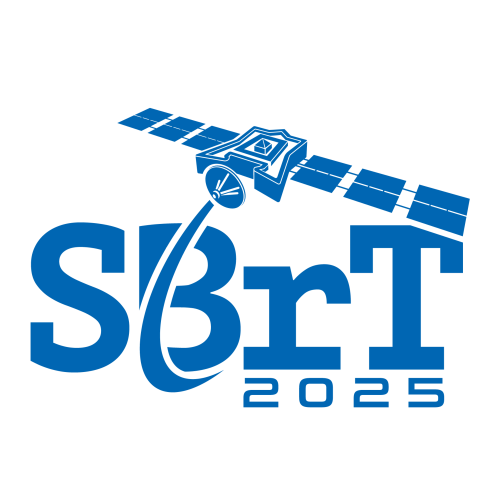
XLIII Simpósio Brasileiro de Telecomunicações e Processamento de Sinais
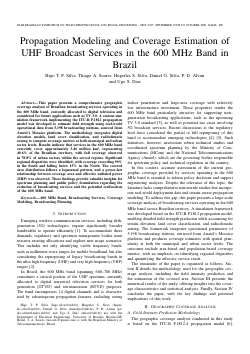
Propagation Modeling and Coverage Estimation of UHF Broadcast Services in the 600 MHz Band in Brazil
Higo Thaian Pereira da Silva, Thiago Aguiar Soares, Hugerles S. Silva, Daniel G Silva, Pedro Duarte Alvim, Ugo Dias
DOI: 10.14209/sbrt.2025.1571155033
Keywords: 600 MHz Band Broadcasting Services Coverage Modeling Broadcasting Planning
Abstract
This paper presents a comprehensive geographic coverage analysis of Brazilian broadcasting services operating in the 600 MHz band, currently allocated to digital television and considered for future applications such as TV 3.0. A custom simulation framework implementing the ITU-R P.1812 propagation model was developed to estimate field strength using real-world operational data from 5,198 broadcasting stations, sourced from Anatel's Mosaico platform. The methodology integrates digital elevation models, land cover classification, and radioclimatic zoning to compute coverage metrics at both municipal and urban sector levels. Results indicate that services in the 600 MHz band currently cover approximately 3.46 million km², representing 40.6% of the Brazilian territory, with full coverage observed in 78.8% of urban sectors within the served regions. Significant regional disparities were identified, with coverage exceeding 90% in the South and falling below 15% in the North. The covered area distribution follows a lognormal pattern, and a power-law relationship between coverage area and effective radiated power (ERP) was observed. These findings provide valuable insights for spectrum planning and public policy formulation regarding the evolution of broadcasting services and the potential reallocation of the 600 MHz band.Download
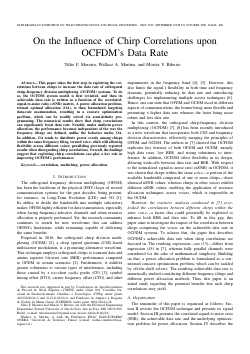
On the Influence of Chirp Correlations upon OCFDM's Data Rate
Túlio F. Moreira, Wallace A. Martins, Moises Vidal Ribeiro
DOI: 10.14209/sbrt.2025.1571155396
Keywords: Correlation Multichirp Power allocation
Abstract
This paper takes the first step in exploiting the correlations between chirps to increase the data rate of orthogonal chirp-frequency division multiplexing (OCFDM) systems. To do so, the OCFDM system model is first revisited, and then its achievable data rate is written as a function of the correlated-signal-to-noise ratio (cSNR) matrix. A power allocation problem, termed optimal allocation (OA), is then formulated targeting data-rate maximization, resulting in a concave optimization problem, which can be readily solved via semi-definite programming. The numerical results show that chirp correlations can significantly boost data rate. Notably, under uniform power allocation, the performance becomes independent of the way the frequency tilings are defined, unlike the behavior under OA. In addition, OA tends to distribute power evenly among chirps within the same frequency tiling, termed voice, while still allowing flexibility across different voices, paralleling previously reported results when disregarding chirp correlations. Overall, the findings suggest that exploiting chirp correlations can play a key role in improving OCFDM's performance.Download
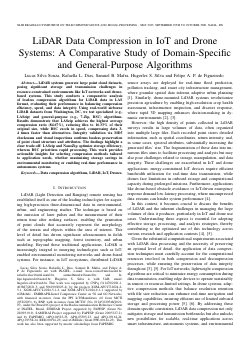
LiDAR Data Compression in IoT and Drone Systems: A Comparative Study of Domain-Specific and General-Purpose Algorithms
Lucas Silva Souza, Rafaella Laureano Dias, Samuel Mafra, Hugerles S. Silva, Felipe Augusto Pereira de Figueiredo
DOI: 10.14209/sbrt.2025.1571155487
Keywords: data compression LiDAR IoT Drone
Abstract
LiDAR systems generate large point cloud datasets, posing significant storage and transmission challenges in resource-constrained environments like IoT networks and drone-based systems. This study conducts a comparative analysis of lossless compression algorithms for LiDAR data in LAS format, evaluating their performance in balancing compression efficiency, speed, and data integrity. Using real-world airborne LiDAR datasets from Washington, DC, we test specialized (e.g., LASzip) and general-purpose (e.g., 7-Zip, BSC) algorithms. Results demonstrate that LASzip achieves the highest average compression ratio (84.67\%), reducing files to 16.33\% of their original size, while BSC excels in speed, compressing data 3-4 times faster than alternatives. Integrity validation via MD5 checksums and visual inspections confirms lossless preservation of point cloud structure and attributes. The findings highlight a clear trade-off: LASzip and NanoZip optimize storage efficiency, whereas BSC prioritizes rapid processing. This work provides actionable insights for selecting compression methods tailored to application needs, whether maximizing storage savings in environmental monitoring or enabling real-time performance in autonomous systems.Download
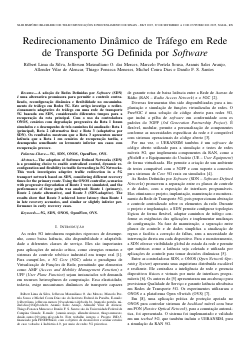
Redirecionamento Dinâmico de Tráfego em Rede de Transporte 5G Definida por Software
Rilbert Lima da Silva, Jefferson Maxmiliano O. das Merces, Marcelo Portela Sousa, Aramis Sales Araujo, Allender Alencar, Thiago Fonseca Meneses, Michel Dias, Danilo F S Santos
DOI: 10.14209/sbrt.2025.1571155662
Keywords: 5G SDN ONOS OpenFlow
Abstract
A adoção de Redes Definidas por Software (SDN) é uma alternativa promissora para permitir o controle centralizado, reconfiguração dinâmica e flexibilidade no encaminhamento de tráfego em Redes 5G. Este artigo investiga o redirecionamento adaptativo de tráfego em uma rede de transporte 5G baseada em SDN, considerando diferentes tempos para a recuperação da rota principal. Com o uso da controladora ONOS, cenários com degradação progressiva da Rota 1 foram simulados e o desempenho de três caminhos foi analisado: Rota 1 (principal), Rota 2 (alternativa fixa) e Rota 3 (adaptativa por SDN). Os resultados mostram que a Rota 3 apresentou menor latência que a Rota 1 em cenários de recuperação tardia, e desempenho semelhante ou levemente inferior nos casos com recuperação precoce.Download

Beamforming Analysis of Linear and Planar Arrays for Next-Generation Wireless Systems
Wendria Cunha Silva, Joao Weyl Costa, Andre Mendes Cavalcante, Karlo Queiroz Costa
DOI: 10.14209/sbrt.2025.1571156179
Keywords: Linear array of dipoles 6G technology in the near field Method of Moments
Abstract
This paper presents a detailed analysis of both linear and planar dipole antenna arrays, with emphasis on beamforming techniques applied to high-frequency environments, such as those expected for 6G networks. Using the Method of Moments (MoM), the electromagnetic behavior of the arrays operating at 28 GHz and their communication capabilities in the near-field region are investigated. The influence of array size on spatial field confinement and beam directionality is explored. The results demonstrate the potential of these arrays to enable more targeted, efficient and reliable mobile communications in future generations of wireless systems.Download

Comparative Performance Analysis of OTFS and OFDM Modulations for Mobile Wireless Communications
José Marcos Leal Barbosa Filho, Danilo Pena, Marília C Muniz, Alvaro A. Machado de Medeiros, Vicente Sousa
DOI: 10.14209/sbrt.2025.1571156218
Keywords: OTFS OFDM delay-Doppler domain
Abstract
This paper provides a quantitative performance comparison between Orthogonal Time Frequency Space (OTFS) and Orthogonal Frequency-Division Multiplexing (OFDM) modulation schemes, focusing on mobile wireless communication scenarios. We evaluate and compare both schemes based on critical communication scenarios and configurations such as mobility levels, modulation orders, multipath environments, and equalizers. The study systematically identifies conditions where OTFS and OFDM each exhibit optimal performance. Results from simulations demonstrate that OTFS outperforms OFDM consistently for high mobility scenarios and multipath environments. Depending on the modulation order, the performance gap between OTFS and OFDM might be very close or many orders of magnitude. Moreover, at low and mid values of SNR, the non-linear equalizer performs better than traditional linear equalizers for OTFS.Download

GAIA-DRL: A Geoenvironmental Agent for Energy Optimization in Batteryless IoT Networks with Ambient Backscatter
Edwardes Amaro Galhardo, Wesley dos Reis Bezerra, Carlos Becker Westphall, Antonio Oliveira-Jr
DOI: 10.14209/sbrt.2025.1571156219
Keywords: GAIA-DRL Batteryless IoT Ambient Backscatter Remote Sensing
Abstract
This work addresses sustainability-driven network design for future wireless systems by integrating batteryless dense IoT networks-based on ambient backscatter communication-with geospatial intelligence and deep reinforcement learning. We propose GAIA-DRL (Geoenvironmentally-Aware Intelligent Agent with Deep Reinforcement Learning), an approach that jointly optimizes throughput, latency, energy efficiency, and interference, while incorporating land-use information such as NDVI and pasture coverage. A geospatially-informed agent controls communication policies using real territorial data. Geographic Information Systems (GIS) and remote sensing techniques enable context-aware decisions, supporting low-cost, low-carbon applications in 6G-ready IoT networks for greenhouse gas monitoring, smart agriculture, and sustainable environmental management.Download

Estimativa de Emissões em Veículos a Combustão baseado em Redes Neurais LSTM e Análise de Incertezas via Monte Carlo Dropout
Ludmila Gomes, Bárbara Cavalcante, Mateus De Sousa, José Hélio Bento Da Silva, Iguatemi E. Fonseca, Juan Moises Mauricio Villanueva
DOI: 10.14209/sbrt.2025.1571156234
Keywords: Emissões veiculares Softsensors Interface OBD-II Avaliação de Incertezas
Abstract
Este artigo propõe um softsensor baseado em redes neurais LSTM para estimar as emissões de CO2 em veículos a combustão, utilizando dados obtidos via OBD-II. A abordagem permite modelar sequências temporais complexas em condições reais de condução. Para quantificar a incerteza das previsões, foi empregada a técnica de Monte Carlo Dropout, permitindo a geração de intervalos de confiança em tempo real. Os resultados indicam alta precisão na estimativa das emissões, com incertezas bem caracterizadas, contribuindo para aplicações em monitoramento ambiental e otimização veicularDownload
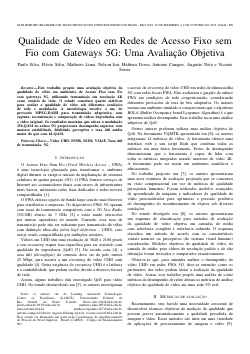
Qualidade de Vídeo em Redes de Acesso Fixo sem Fio com Gateways 5G: Uma Avaliação Objetiva
Paulo E. da Silva Jr, Flávio de Andrade Silva, Mathews Phillipp Santos de Lima, Nelson Ion de Oliveira, Matheus F. de S. Dória, Antonio Campos, Augusto Venâncio Neto, Vicente Sousa
DOI: 10.14209/sbrt.2025.1571156238
Keywords:
Abstract
Este trabalho propõe uma avaliação objetiva da qualidade de vídeo em ambientes de Acesso Fixo sem Fio com gateways 5G, utilizando transmissão em resolução 4K como cenário de teste. O estudo considera quatro métricas para avaliar a qualidade de vídeo sob diferentes condições de rede e modulação. A metodologia envolve o uso do protocolo MPEG-DASH para transmissão adaptativa, com captura, reconstrução e comparação de vídeos degradados com o vídeo original. Os resultados mostram que ativar a modulação 256-QAM no enlace 5G proporciona desempenho superior, com maiores estabilidade, fidelidade perceptiva e taxa útil média maior do que com 64-QAM.Download

Correção de Iluminação usando YOLOP para Detecção de Faixas em Ambientes de Direção Autônoma
Igor Mahall Sousa, Georgio S. Colares, Myke Valadão, José Linhares, Gabriel Araujo, Frederico da Silva Pinagé, Waldir Silva, Celso Carvalho
DOI: 10.14209/sbrt.2025.1571156249
Keywords: Correção de Iluminação Detecção de Faixas YOLOP Direção Autônoma
Abstract
This work investigates the impact of illumination correction on lane detection in autonomous driving scenarios. We employ YOLOP, a deep learning-based architecture capable of real-time drivable area segmentation and lane detection. Three preprocessing techniques were evaluated: AWB, SCL-LLE, and Wavenet. Experiments were conducted using the VIL-100 and CULane datasets, with standard evaluation metrics including mP, mR, mIoU, and mAP. While AWB showed limitations under adverse lighting conditions and Wavenet delivered moderate results, SCL-LLE stood out for its semantic-aware correction, yielding the best overall performance, particularly on the VIL-100 dataset. We conclude that techniques leveraging semantic information significantly enhance YOLOP's robustness and detection accuracy under varying lighting. The proposed approach proves to be a viable strategy to improve visual perception in embedded systems for autonomous vehiclesDownload